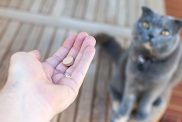Siberian cats, glamorous natives of Siberia’s subarctic taiga, owe their thick, protective coats to their harsh environment. Highly affectionate and playful when they want to be, these cats don’t need much exercise and are just as happy snuggling up with their humans as they are chasing a laser toy. They’ll follow you everywhere and gladly participate in whatever you’re doing, whether you like it or not. If you crave a warm cuddle buddy, the Siberian cat may be the perfect feline family member.
When considering a Siberian, it’s advisable to prioritize adopting from rescue organizations or shelters to provide a loving home to a cat in need. However, if you decide to purchase a Siberian kitten, it’s crucial to choose a reputable breeder. Conduct thorough research to ensure that the breeder follows ethical practices and prioritizes the well-being of their cats. Reputable Siberian breeders prioritize the health and temperament of their cats, conduct necessary health screenings, and provide a nurturing environment for the kitties. This active approach ensures that you bring home a healthy and happy kitty while discouraging unethical breeding practices.
Siberian Cat Quick Facts
- Origin: Siberia, Russia
- Size: Medium to large
- Breed group: Natural
- Lifespan: 12-15 years
- Coat: Thick, triple coat with a variety of colors and patterns
- Temperament: Affectionate, playful, and intelligent
- Exercise needs: Moderate
- Training: Trainable
- Grooming: Moderate
- Health: Generally healthy, but prone to certain health conditions, such as hypertrophic cardiomyopathy (HCM) and hip dysplasia
- When they were originally introduced to the West, they were called Russian Longhairs.
- The Neva Masquerade is a sister breed or colorpoint variety of Siberian cat. They are now largely considered separate breeds.
- The Siberian is the National Cat of Russia.
- Their coats are water-repellant, and they like to play in water.
- The 2016 movie “Nine Lives” is about a dad (Kevin Spacey) who switches places with his daughter’s Siberian cat.
Siberian Pictures
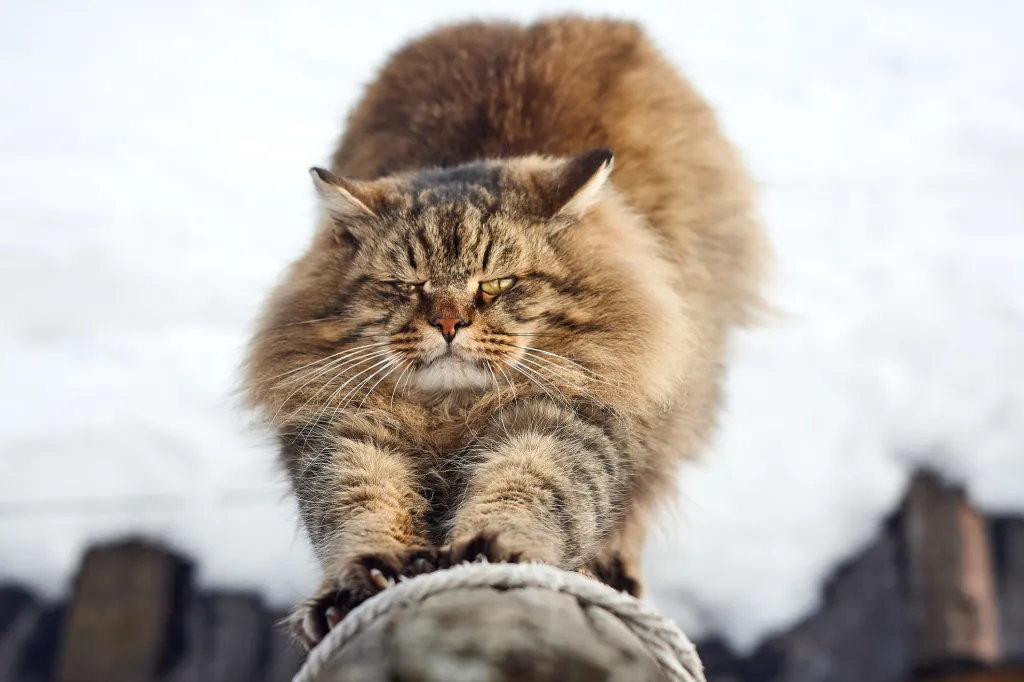
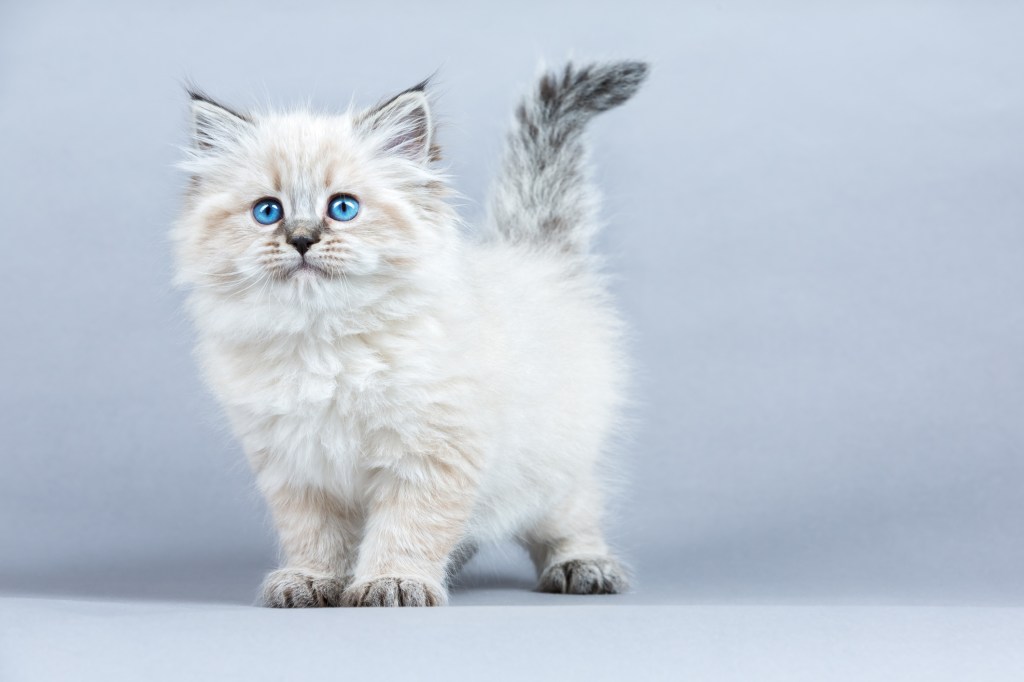
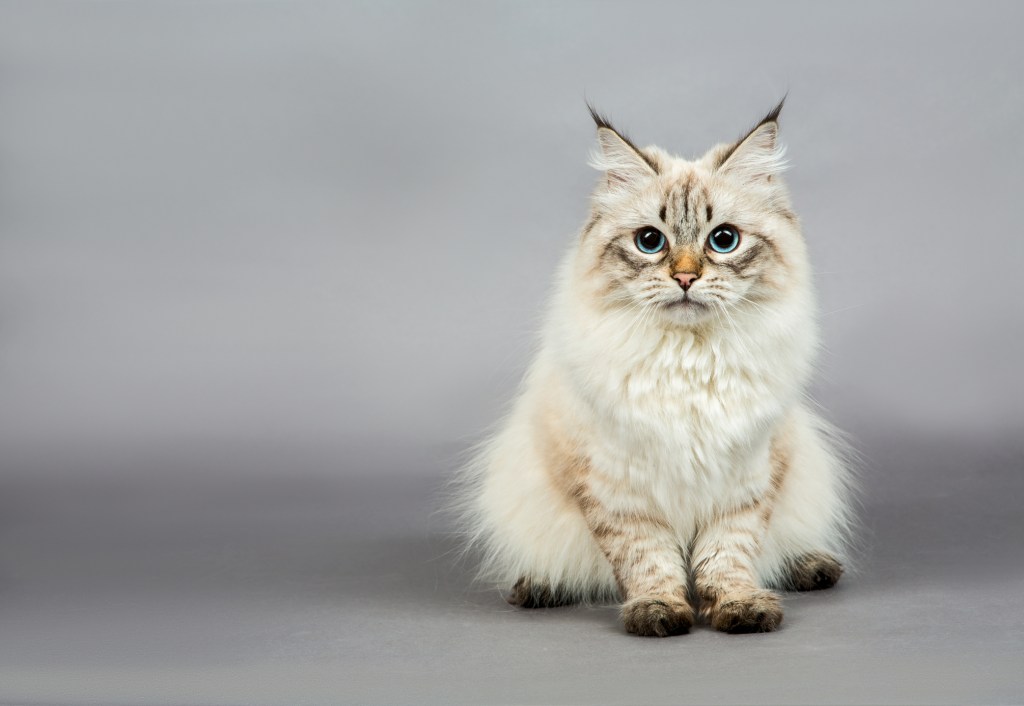
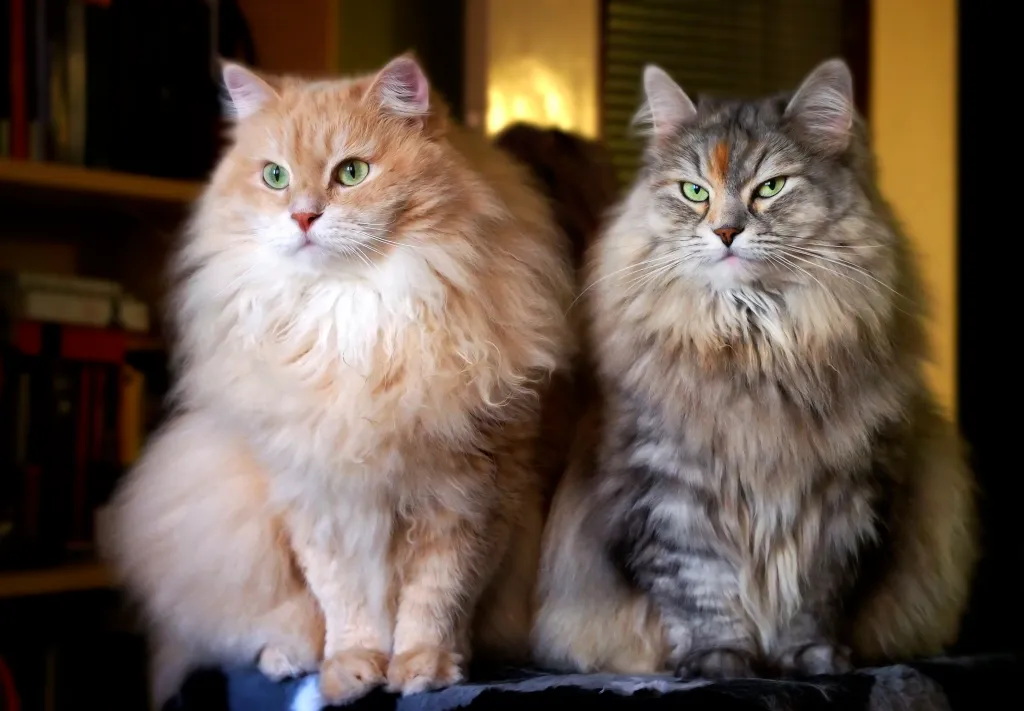
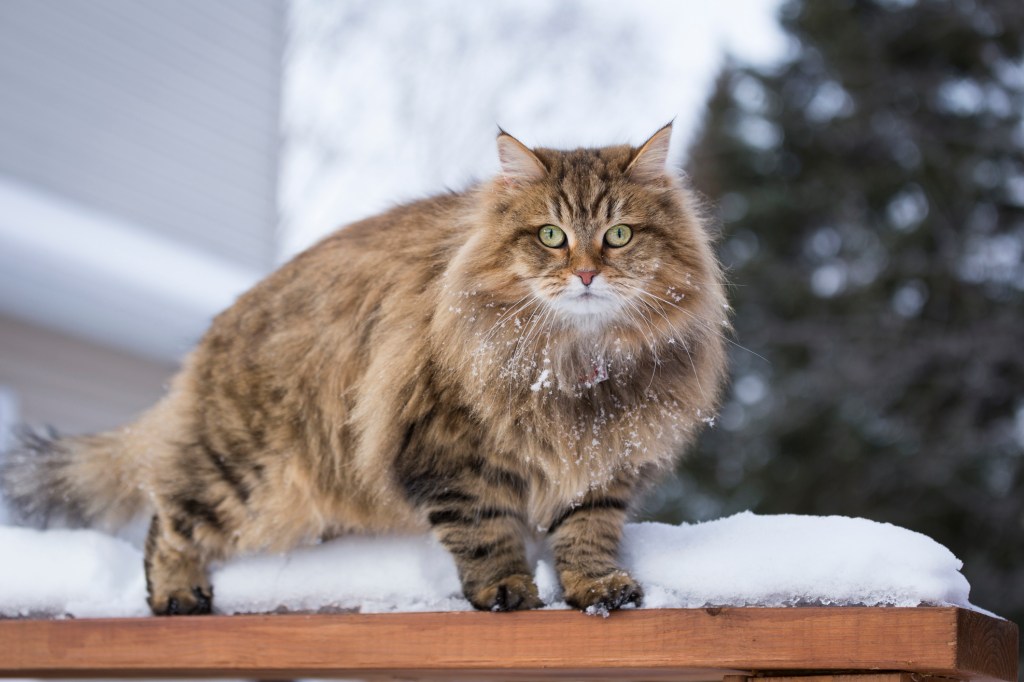

-
Affectionate with Family
Some cat breeds are typically independent and aloof, even if they’ve been raised by the same person since kittenhood; others bond closely to one person and are indifferent to everyone else; and some shower the whole family with affection. Breed isn’t the only factor that goes into affection levels; cats who were raised inside a home with people around feel more comfortable with humans and bond more easily.

See Cats Less Affectionate with Family -
Amount of Shedding
If you’re going to share your home with a cat, you’ll need to deal with some level of cat hair on your clothes and in your house. However, shedding does vary among the breeds. If you’re a neatnik, you’ll need to either pick a low-shedding breed or relax your standards. This furniture cover can make it easier to clean up cat hair and keep it off your sofa!
-
General Health
Due to poor breeding practices, some breeds are prone to certain genetic health problems. This doesn’t mean that every cat of that breed will develop those diseases; it just means that they’re at an increased risk. If you’re looking only for purebred cats or kittens, it’s a good idea to find out which genetic illnesses are common to the breed you’re interested in.
-
Potential for Playfulness
Some cats are perpetual kittens—full of energy and mischief—while others are more serious and sedate. Although a playful kitten sounds endearing, consider how many games of chase the mouse-toy you want to play each day, and whether you have kids or other animals who can stand in as playmates. A classic wand cat toy like this one is perfect for playful felines!
-
Tendency to Vocalize
Some breeds sound off more often than others with meows, yowls, and chattering. When choosing a breed, think about how the cat vocalizes and how often. If constant “conversation” drives you crazy, consider a kitty less likely to chat.
-
Kid-Friendly
Being tolerant of children, sturdy enough to handle the heavy-handed pets and hugs they can dish out, and having a nonchalant attitude toward running, screaming youngsters are all traits that make a kid-friendly cat. Our ratings are generalizations, and they’re not a guarantee of how any breed or individual cat will behave; cats from any breed can be good with children based on their past experiences and personality.
-
Friendly Toward Strangers
Stranger-friendly cats will greet guests with a curious glance or a playful approach; others are shy or indifferent, perhaps even hiding under furniture or skedaddling to another room. However, no matter what the breed, a cat who was exposed to lots of different types, ages, sizes, and shapes of people as a kitten will respond better to strangers as an adult.
-
Easy to Groom
Some breeds require very little in the way of grooming; others require regular brushing to stay clean and healthy. Consider whether you have the time and patience for a cat who needs daily brushing. You should definitely pick up this awesome de-shedding tool for cats of any hair length!
-
Intelligence
Some cat breeds are reputed to be smarter than others. But all cats, if deprived the mental stimulation they need, will make their own busy work. Interactive cat toys are a good way to give a cat a brain workout and keep them out of mischief. This scratcher cat toy can keep your smart kitty busy even when you’re not home!
-
Pet Friendly
Friendliness toward other household animals and friendliness toward humans are two completely different things. Some cats are more likely than others to be accepting of other pets in the home.
Siberian History
From Russia with love: that’s the Siberian, a glamorous native cat from the taiga of Siberia, a forested area with a subarctic climate that no doubt contributed to this cat’s long, thick, protective coat. The cats have been known in Russia for some 1,000 years and often figure in Russian folktales.
As in every culture, the cats were prized for their hunting ability by householders and shopkeepers. They kept mice and rats well away from stores of grain and other foods. Siberians were first imported to the United States in 1990 and were recognized by The International Cat Association in 1996. The American Cat Fanciers Association accepted the breed in 1999, followed by the Cat Fanciers Association in 2006. The breed is gaining popularity because it has a reputation for being hypoallergenic—which may or may not be the case, depending on the individual person.
Siberian Size
This cat typically weighs 8 to 17 pounds — and sometimes more.
Siberian Personality
The Siberian’s heart is as warm as his homeland is cold. He loves people and wants to be near them, so expect this affectionate cat to follow you around, including to the bathroom, and to “help” you with all of your reading, TV viewing, computer work and meal prep. Sitting in your lap while you comb his fur may well be the highlight of his day.
When you come home from work, he might not have a martini waiting, but he will be pleased to tell you all about his day in quiet, pleasant trills and chirps, interspersed with a few meows and purrs. Guests will find him to be a genial host; this is not typically a cat who is shy in the presence of strangers.
Besides being loving and attentive, the Siberian is also active and playful. He will instigate games of fetch by bringing you a favorite toy to throw. Any item can become a plaything for this clever cat, so keep jewelry or other potentially intriguing items out of his sight. Teaching him tricks is a fun and easy way to challenge his agile brain. Because of his heritage as a forest dweller, he likes playing with water—perhaps it’s a genetic memory of going fishing for his supper. Don’t be surprised if he enjoys splashing you in the tub, drinking from a fountain or faucet, or making puddles by batting his paw in his water dish.
As befits a working and hunting cat, he’s highly athletic and you may find him balancing atop a doorway or propelling himself to the highest point in the room. In fact, Siberian coaches may well be the secret to the success of Russian gymnasts. Activity and noise won’t bother him a bit. His calm nature gives him the potential to be a therapy cat. If nothing else, he will be happy to snuggle with you when you’re down with a cold or other illness. And although he loves attention, he’s not needy and will wait patiently until you have time to devote to him.
Siberian Health
Both pedigreed cats and mixed-breed cats have varying incidences of health problems that may be genetic in nature. Siberians are generally healthy due to their natural breeding. Here are some common problems that might affect a Siberian cat:
- Hypertrophic Cardiomyopathy is a form of heart disease that causes the heart muscle to enlarge. It is found in pedigreed and non-pedigreed cats. Siberians are one of the breeds that may be affected by this disease.
- Locomotor Injury: With their curiosity and activity levels, these cats might suffer from an injury due to their athletic and adventuresome personalities.
Siberian Care
The Siberian’s thick triple coat should be combed or brushed a couple of times a week to prevent tangles or mats. The coat will shed seasonally in the spring and fall, and you may need to groom more frequently during that time. A bath is rarely necessary, which is a good thing because the coat is highly water-resistant. It can be difficult to get a Siberian wet enough to shampoo him.
Brush the teeth to prevent periodontal disease. Daily dental hygiene is best, but weekly brushing is better than nothing. Trim the nails every couple of weeks. Wipe the corners of the eyes with a soft, damp cloth to remove any discharge. Use a separate area of the cloth for each eye so you don’t run the risk of spreading any infection. Check the ears weekly. If they look dirty, wipe them out with a cotton ball or soft damp cloth moistened with a 50-50 mixture of cider vinegar and warm water. Avoid using cotton swabs, which can damage the interior of the ear.
Most of the Siberian’s growth occurs in his first year and a half of life. Your kitten’s breeder may recommend that you feed him kitten food during that time to make sure he gets enough nourishment.
Keep the litter box spotlessly clean. Cats are very particular about bathroom hygiene, and a clean litter box will also help to keep the long coat clean. It’s a good idea to keep a Siberian as an indoor-only cat to protect him from diseases spread by other cats, attacks by dogs or coyotes, and the other dangers that face cats who go outdoors, such as being hit by a car. Siberians who go outdoors also run the risk of being stolen by someone who would like to have such a beautiful cat without paying for it. If possible, build your Siberian a large outdoor enclosure where he can jump and climb safely.
Siberian Coat Color And Grooming
The Siberian is notable for having a long triple coat with guard hairs (the outer coat), awn hairs (the middle part of the coat) and a downy undercoat. He has an abundant ruff around the neck, thick but slightly shorter hair on the shoulder blades and lower part of the chest, and thick fur on the belly and britches (the upper hind legs). The undercoat thickens in cold weather.
The coat comes in all colors and combinations of colors, with or without white. He looks powerful and alert, but gazes out at the world with a sweet expression. His head is a modified wedge with rounded contours—broad at the top and narrowing slightly at the muzzle. Medium-large ears are well furnished with tufts of fur. The nearly round eyes can be green, gold, green-gold, or copper. White Siberians or Siberians with white patches may have blue or odd eyes.
The “hefty, hefty, hefty” slogan could have been written with the Siberian in mind. This is a medium-size to large cat weighing 8 to 17 pounds and sometimes more. It can take the Siberian up to five years to reach his full size and coat. His body is muscular and he has big round paws with tufts of fur and a thickly furred tail.
Children And Other Pets
The Siberian has a bold temperament, and nothing much ruffles his composure. These characteristics make him an excellent choice for a family with kids. No nighttime monsters will get past the Siberian on guard at the foot of a child’s bed. He is happy to live with other cats and cat-friendly dogs, too, as long as they recognize that he’s in charge. Introduce pets slowly and in controlled circumstances to ensure that they learn to get along together.
Siberian Rescue Groups
More Info For You
If you’re also looking for a dog, check out DogTime’s dog breed page!



